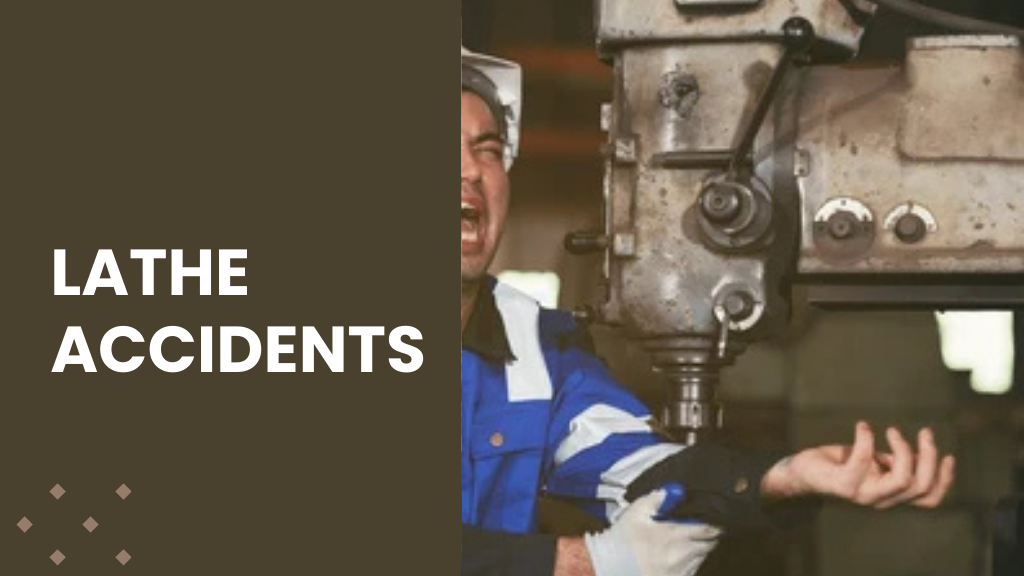Lathe machines are essential tools in manufacturing, metalworking, and woodworking industries. Their ability to shape, cut, and finish materials with precision makes them indispensable in both large-scale factories and small workshops. However, despite their utility, lathes pose significant hazards, and improper use, lack of training, or insufficient safety measures can lead to serious lathe accidents. Awareness and adherence to safety protocols are crucial to prevent injuries and ensure a safe working environment.
Understanding the risks of lathe accidents and implementing effective safety strategies is vital for protecting operators and creating a safer work environment. This article explores the prevalence of lathe accidents, common risks, preventive measures, and real-world examples, providing valuable insights for anyone working with or around these powerful machines.
How Common Are Lathe Accident?
Lathe accidents are more common than many people realize. Each year, thousands of workers sustain injuries while operating lathe machines, ranging from minor cuts and bruises to severe injuries like amputations. In the United States alone, metal lathe operators experience several thousand lost-time injuries annually. These accidents often result from operator error, insufficient training, lack of proper personal protective equipment, or unsafe machinery conditions.
Globally, lathe accidents are reported in industries ranging from automotive and aerospace to furniture and tool manufacturing. Reports indicate that even experienced operators are not immune, emphasizing the importance of vigilance and adherence to safety protocols. Workplace injuries caused by lathes can have long-lasting consequences, not just for the injured worker, but also for businesses in terms of lost productivity, insurance claims, and potential legal liability.
What Are the Risks of Lathes?
Lathes, while extremely useful, contain multiple hazards that operators must respect. Understanding these risks is the first step in preventing accidents.
1. Entanglement Hazards
One of the most serious risks involves entanglement. The rotating components of a lathe, including the chuck and spindle, can easily catch loose clothing, jewelry, or even long hair. When this happens, the operator may be pulled into the machine, resulting in severe injuries or fatalities. Even small items like rings or bracelets can cause a dangerous accident if they come into contact with moving parts. Ensuring that operators wear fitted clothing and secure long hair can significantly reduce this risk.
2. Flying Debris
Another common risk is flying debris. During lathe operations, improperly secured workpieces or cutting tools can become projectiles. This debris can strike the operator or nearby workers, causing eye injuries, burns, or other serious trauma. Lathe operations also produce metal or wood chips that can cause cuts or punctures if proper protective gear is not used.
3. Pinch Points and Crushing Hazards
Pinch points occur where moving parts of the lathe come into close proximity. Fingers, hands, or other body parts caught in these points can be crushed or severed. Lathes also have feed mechanisms and tailstocks that can trap limbs if the operator is not careful. Understanding the locations of pinch points and avoiding unnecessary contact with moving parts are critical for safety.
4. Noise and Vibration
Extended exposure to noise and vibration from lathe operations can cause long-term health problems, including hearing loss, musculoskeletal disorders, and repetitive strain injuries. These effects may not be immediately noticeable but can accumulate over time. Proper use of hearing protection and ergonomic work practices are essential for minimizing these risks.
5. Burns and Chemical Hazards
In some lathe operations, lubricants, coolants, or cutting oils are used. Contact with these substances or hot surfaces can result in chemical burns or skin irritation. Proper handling of chemicals, wearing gloves when appropriate, and following manufacturer guidelines are important preventive measures.
Causes of Lathe Accidents
Lathe accidents typically result from a combination of human error and mechanical hazards. Understanding the main causes is essential for preventing injuries and ensuring a safe working environment. By addressing both operator behavior and machine condition, shops can significantly reduce the likelihood of accidents and maintain productivity.
-
Inadequate Training
Many accidents occur because operators are unfamiliar with the machine or lack proper training in safety procedures. Without hands-on instruction and guidance, users may make critical errors during operation. Comprehensive training programs, including demonstrations and written manuals, are necessary to ensure that all operators understand how to safely use the lathe.
-
Improper Use
Using a lathe for tasks it was not designed for, or bypassing safety protocols, greatly increases the risk of accidents. Operators must follow manufacturer guidelines and avoid shortcuts that compromise safety. Even experienced machinists can be injured if machines are misused or handled carelessly.
-
Lack of Maintenance
Machines that are not regularly inspected and maintained can malfunction, creating hazardous situations. Worn or damaged parts, unlubricated components, and malfunctioning safety guards all contribute to accidents. Routine maintenance checks are essential to keep lathes operating safely and reliably.
-
Distractions and Fatigue
Operators who are distracted or fatigued are more likely to make mistakes that can result in injury. Maintaining focus during lathe operation is critical, as even minor lapses can lead to severe consequences. Proper scheduling, adequate rest, and minimizing workplace distractions help reduce this risk.
-
Ignoring Personal Protective Equipment
Not wearing essential protective gear such as safety glasses, gloves, or hearing protection increases the severity of injuries when accidents occur. PPE cannot prevent accidents by itself but is vital for minimizing harm. Ensuring that all operators consistently use appropriate safety equipment is a key part of lathe safety.
Safety Measures to Prevent Lathe Accident
Lathe operations are inherently risky, but following proper safety measures can significantly reduce the likelihood of accidents. A combination of training, protective equipment, maintenance, and workplace organization is essential. By implementing these practices, operators can work confidently while minimizing hazards. Regular monitoring and adherence to safety protocols are key to creating a safe machining environment.
-
Proper Training and Supervision
Comprehensive training is the foundation of lathe safety. Operators should understand machine components, operational procedures, and emergency protocols. Employers should provide hands-on demonstrations, written manuals, and periodic refreshers. Supervision ensures adherence to safety standards and allows immediate intervention if unsafe practices are observed.
-
Use of Personal Protective Equipment
Essential personal protective equipment includes safety glasses, hearing protection, gloves when appropriate, and protective footwear. Safety glasses protect the eyes from flying debris, hearing protection prevents long-term damage from machine noise, and gloves can shield hands from chemical exposure or minor abrasions. However, gloves should be used carefully because they can also pose entanglement risks if not properly fitted.
-
Regular Maintenance and Inspections
Routine maintenance checks ensure that all machine components function correctly and safely. Maintenance should include verifying the integrity of guards, testing emergency stop buttons, lubricating moving parts, and checking for worn or damaged tools. A machine in optimal condition is far less likely to cause accidents.
-
Safety Guards and Shields
Physical barriers or shields around moving parts prevent accidental contact. Modern lathes often include transparent shields that allow operators to monitor the workpiece without being exposed to hazards. Guarding is particularly important for high-speed operations where flying debris or entanglement risks are elevated.
-
Housekeeping and Work Environment
A clean and well-organized workspace reduces the risk of slips, trips, and falls. Proper lighting, clear walkways, and organized tool storage improve visibility and reduce distractions. Operators should also avoid clutter around the machine to prevent accidents.
-
Emergency Protocols
Workplaces should establish emergency procedures for accidents, including clearly marked emergency stop buttons, first aid stations, and protocols for medical response. Regular drills and refresher training ensure that employees know what to do if an accident occurs.
Real-World Examples of Lathe Accidents
Lathe operations can be extremely dangerous if proper safety measures are not followed. Even experienced operators can face severe injuries from common oversights or equipment failures. These real-world cases illustrate the importance of strict adherence to safety protocols, proper training, and regular machine maintenance.
Case 1: Hand Amputation
An employee suffered a severe hand injury when it became caught in the lathe spindle. The accident occurred because the operator was wearing loose sleeves and failed to engage the safety guard. This incident highlights the critical importance of wearing appropriate attire and actively using safety features. Following safety procedures could have prevented this life-altering injury.
Case 2: Fatal Injury from Ejected Part
A worker was fatally injured by an ejected machine part during lathe operation. The workpiece had not been properly secured, and the operator did not adhere to established safety procedures. This tragic example demonstrates the lethal potential of flying debris and reinforces the need for careful setup and inspection. Proper precautions can prevent such devastating accidents.
Case 3: Eye Injury from Flying Chip
A machinist sustained an eye injury when a small metal chip flew off a rotating workpiece. Although wearing safety glasses, the impact caused a minor corneal abrasion. This case emphasizes that even minor procedural oversights can result in injury. It also highlights the importance of correctly wearing personal protective equipment at all times.
Case 4: Injury Due to Mechanical Failure
A lathe malfunction caused the tailstock to move unexpectedly, pinching the operator’s fingers. Regular maintenance had been neglected, leading to worn parts that failed under stress. This example underlines the necessity of routine inspections, preventive maintenance, and proper machine care. Consistent upkeep is crucial to avoid accidents caused by mechanical failures.
Common Misconceptions About Lathe Safety
Working with lathes requires strict attention to safety, yet many operators believe myths that can put them at risk. Understanding common misconceptions helps prevent accidents and ensures safe operation for both professionals and hobbyists.
-
Experienced Operators Are Immune
A common misconception is that experienced operators are immune to accidents. Even seasoned machinists can be injured if safety protocols are ignored or if machinery malfunctions unexpectedly. Awareness and constant vigilance are essential regardless of experience level.
-
Small Lathes Are Safe
Another myth is that small lathes or bench-top machines are completely safe. Despite their size, these lathes still pose serious hazards, including entanglement, flying debris, and pinch points that can cause injury. Proper precautions are required for all lathe sizes.
-
PPE Alone Is Enough
Some operators believe that personal protective equipment (PPE) alone is sufficient. While PPE is essential, it cannot replace proper training, regular machine maintenance, and adherence to safe operational practices. Comprehensive safety measures are required to minimize risk.
Best Practices for Lathe Safety
- Always secure loose clothing, hair, and jewelry before operating a lathe.
- Conduct pre-operation checks to ensure all guards and emergency stops are functional.
- Use the correct cutting tools and speed settings for each material.
- Maintain a clean, organized workspace to reduce distractions and hazards.
- Participate in regular safety training and drills.
- Encourage reporting of near misses to identify risks before accidents occur.
- Implement a buddy system or supervision in high-risk operations.
Conclusion
Lathe machines are indispensable tools across various industries, but they carry significant risks if not handled safely. Accidents can occur due to operator error, mechanical failure, or environmental hazards, resulting in injuries ranging from minor cuts to fatalities. Awareness of these risks, proper training, adherence to safety protocols, and the use of personal protective equipment are essential to reducing accidents. Regular maintenance, machine guarding, and emergency preparedness further enhance safety. By fostering a culture of safety and vigilance, employers and operators can ensure that lathe operations remain productive while minimizing risks to personnel.
Lathe accidents can have serious consequences, but proactive measures and continuous safety awareness can significantly reduce their occurrence. Workplace safety is a shared responsibility, and everyone involved with lathe operations must be committed to preventing injuries. Prioritizing safety protects not only individual workers but also the long-term success and productivity of the business.
Frequently Asked Questions
What should I do if my clothing gets caught in a lathe?
Immediately hit the emergency stop button and seek assistance. Trained personnel should follow established procedures to safely disengage the machine and provide medical attention if necessary.
Are there specific regulations governing lathe safety?
Yes, regulatory bodies provide guidelines for machine safety. In the United States, OSHA enforces regulations for metalworking machines, including lathes. Employers are required to follow these guidelines to ensure safe working conditions.
Can lathe accidents be prevented entirely?
While no workplace can eliminate all risks, strict adherence to safety protocols, proper training, and routine maintenance significantly reduce the likelihood of accidents.
How do I report a lathe accident at work?
Report the incident to your supervisor immediately. Most workplaces have an internal reporting system for workplace injuries, which may also involve OSHA reporting for serious incidents.
What are some common first aid measures for lathe injuries?
First aid measures depend on the injury type. Minor cuts should be cleaned and bandaged, while severe injuries such as amputations or deep lacerations require immediate professional medical attention.




